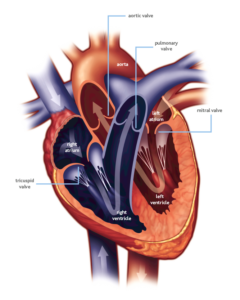Heart valve disease is the name given to any malfunction or abnormality of one or more of the heart’s four valves, affecting the blood flow through the heart. The condition is usually caused by wear, disease or damage of the heart valve(s).
The heart has four chambers and is responsible for pumping blood around the body. There are a series of valves in the heart which, when working properly, ensure that blood flows in the right direction. Diseased or defective heart valves – those that have become narrowed (stenosis), leaky (regurgitation) or both) may not open or close properly and can interfere with the flow of blood.
The primary types of heart valve disease are:
Valve Stenosis or Obstruction: As a result of certain medical conditions or anatomical abnormalities, a valve can either be exceptionally narrow (therefore having a “stenosis”) or have a blockage or obstruction. Either of these conditions can limit the blood flow through the valve, which may result in a “back-up” of blood behind the valve as if behind a dam, causing the heart to pump inefficiently or building up blood pressure in the lungs.
Valve Regurgitation or Insufficiency: When a valve’s leaflets fail to close completely, the valve itself can become “leaky,” allowing blood to backwash down through the valve (called “regurgitation”). In addition, the valve may not ever completely move the volume of blood to the next appropriate chamber.

Signs of heart valve disease include, but are not limited to:
- Shortness of breath
- Fainting
- Cough
- Chest tightness and / or pain
- Fatigue
- Lightheadedness or dizziness
- Abnormal heart rhythm sensations (irregular heart beat)
These symptoms are not always severe or visible and are often seen as a party of the natural aging process, meaning that the symptoms are classified as ‘asymptomatic’.
Diagnosis
The symptoms of heart valve disease can be similar to the symptoms of other forms of heart disease or problems with the lungs.
To diagnose heart valve disease, the doctor needs to have a suspicion that it may be the heart valves that are causing the problem and use a stethoscope to listen for the characteristic heart “murmur” or “click-murmur” which is usually the first indication of a heart valve disorder.
After initial diagnosis, a more sophisticated investigation with either an echocardiogram or another form of heart scan can be undertaken to understand the exact type of heart valve disease and the severity of the abnormality.
If you are worried that you may be suffering from Heart Valve Disease, please go see your primary care physician.
Please visit the Resources section of this site to download materials designed to help you prepare for your visit to your physician and ensure you get the most efficient and helpful consultation possible.
Treatment
In the early stages of heart valve disease, when it is less severe and not causing any significant symptoms, it may be best simply to monitor your condition and see how things develop. However, the earlier the diagnosis and treatment of heart valve disease, the better the patient prognosis.
It is therefore very important that you regularly monitor your symptoms with your doctor so that any deterioration is recognized quickly and can be treated.
The most common treatment for heart valve disease is surgery. In some cases, the aortic valve can be repaired during surgery and the patient’s tissue maintained. More often, aortic valve replacement is required using either a mechanical valve or a tissue valve from an animal.
Mitral valves are more commonly treated with repair procedures, but can require a valve replacement. In addition to more traditional forms of open heart surgery, there are now less invasive approaches which allow valves to be inserted via a small incision and a catheter placed in the groin.
These treatments may be suitable for some patients who are at higher risk from the more traditional forms of surgery.
